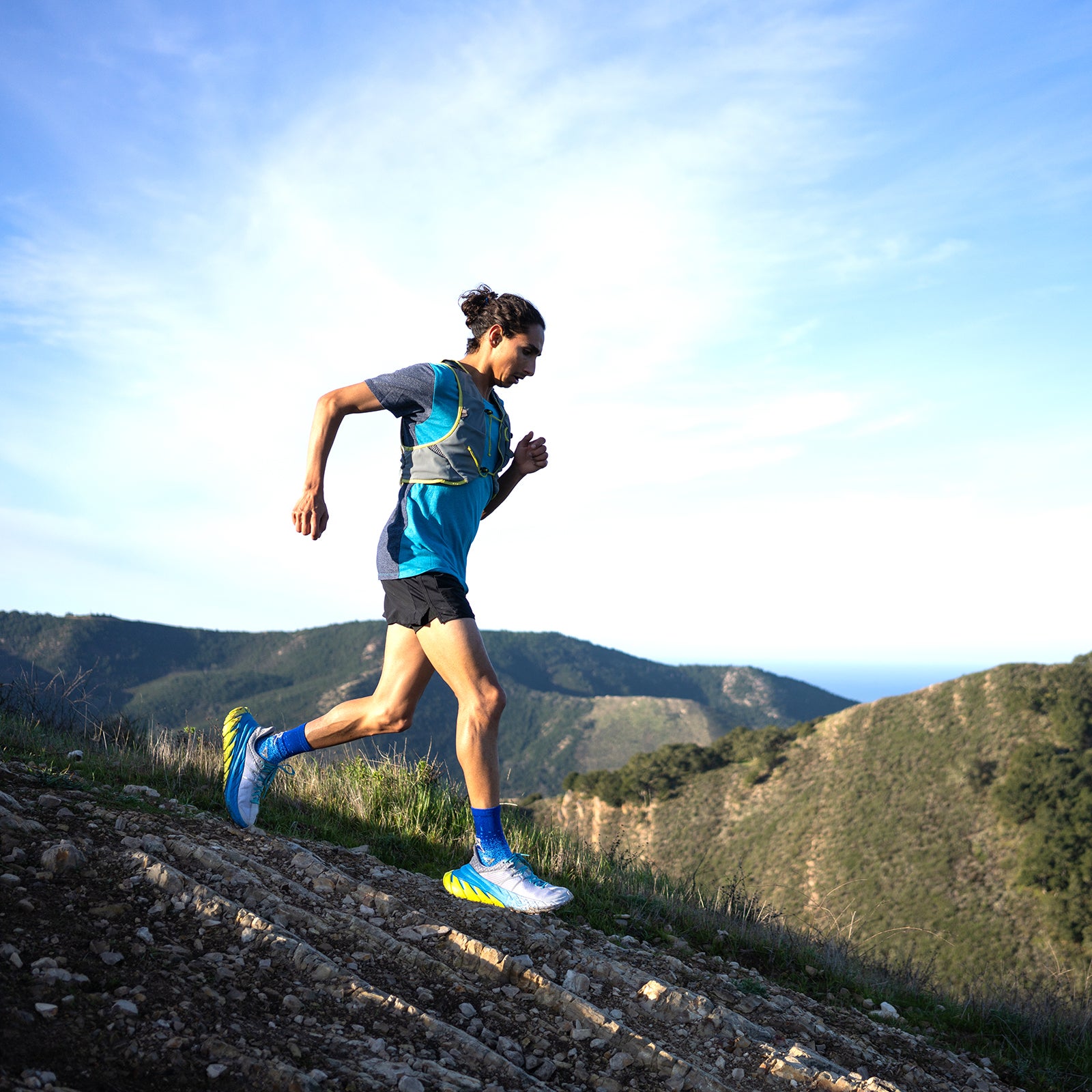Not too long ago, running shoes weren’t a source of controversy. You found a pair that worked,��and that was that. This era of innocence appears to be over, thanks largely to the disruptive impact of Nike’s Vaporfly racer. The shoe, first released in 2017, combined an extravagant amount of Pebax foam with a carbon-fiber plate to allegedly confer unprecedented performance benefits. Suddenly, shoe tech was a significant factor in determining who was going to win races. In order to keep things from getting out of hand, World Athletics, track and field’s global governing body, announced new regulations in January��decreeing��that a shoe’s heel stack height could not exceed 40 millimeters for it to be eligible in competition. We have entered the era of the shoe war.
Thus far��the controversy has mainly been limited to road running.��Trail running has been largely unaffected—at least until��the , Hoka’s latest offering, showed up. At 33 millimeters in the heel and 29 millimeters in the forefoot, the shoe has a stack height similar to Nike’s Vaporfly models. (It also comes with the same $250 price tag.)��But the shoes aren’t just��fat. They’re cartoonishly long: the midsole juts out several inches behind the heel.
Hoka, of course, was ahead of the game when it came to making fat-soled sneakers. The company sprung up in 2009, the same year that Born to Run made the case for minimalist running. But from the start, Hoka went in the other direction. Its designers were convinced that the gnarly topographies of the trail and ultra scenes required more (rather than less) cushioning and proceeded to make footwear that, in the words of star ultrarunner and early adopter Karl Meltzer, “looked like clown shoes.”
Even by Hoka’s standards, the TenNine’s silhouette represents a dramatic departure from previous paradigms. However, unlike Nike’s Vaporfly, Hoka’s main goal is not to improve running economy; it’s to increase surface area in order to “maximize ground contact.” That might sound like a strange boast for a running shoe, but Hoka’s argument is that more ground contact equals superior stability, something that’s essential when you’re bombing down the trail à la��Jim Walmsley. The new kicks are essentially powder skis for trail running.
A few days after their launch, I received a pair of TenNines��for testing. Immediately, I assumed that Hoka had sent me the wrong size, as these were several inches longer than any shoe I had ever owned.��Also, I’d never��seen a pair of sneakers with their own warning label. Inside the shoebox, a small card marked “CAUTION” explained that, “Using this product for anything other than running may impair balance and dexterity. So, don’t wear these on stairs or while driving.”
Since I live in a neighborhood with lots of small children, I figured the responsible thing to do was to take Hoka’s word for it on the driving front.��I can, however, confirm that it’s treacherously easy to clip your heel while descending a flight of stairs in a pair of TenNines.
As for the actual running experience, the TenNines are surprisingly nimble for shoes that look like you could paddle them out to sea.��Once I survived my building’s staircase, I was able to cruise the two miles to my local park without tripping over my feet. Upon arrival, I tested the shoes on an undulating trail network, pushing the downhill sections. As advertised, the downhills are where the TenNine’s dramatic design becomes most noticeable. I’d be overstating things if I claimed that the increased ground contact made me feel like I was floating��as I scrambled down leaf-strewn terrain, but I definitely felt more sure-footed. If you have chronic ankle-twisting issues, this might be a product for you. And even though propulsion is not high on the list of the TenNine’s purported benefits, the shoe’s gargantuan, wedge-like heel pushes you onto your toes with every step when running downhill.��
Will the TenNine revolutionize trail running?��I wouldn’t count on it, primarily because the supersized��extended midsole also adds weight. When I placed the TenNine on a kitchen scale, my men’s size ten��came in at 370 grams (roughly 13 ounces). That’s nearly twice the weight of the Vaporfly Next %, which weighs 198 grams (roughly seven ounces). While trail shoes certainly need to be burlier than their road-specific counterparts, race models still need to be as light as possible while providing adequate cushioning. Don’t expect Hoka-sponsored athletes to forsake the brand’s tried-and-true ultra racers, like the Mafate or��Speedgoat��(both of which are roughly three ounces lighter than the TenNine), for this shoe.
In addition to��trail fanatics who might welcome the idea of having an extensive running-shoe quiver, I could see them potentially working as a recovery shoe for roadies. On my second day, I took them out for an easy (paved) ten miles. My feet felt like they were encased in giant pillows of foam. It’s rather pleasant, if you can ignore all the people staring at you and wondering what the hell is on your feet.��
If the shoe’s ostentatious silhouette weren’t intimidating enough, the hefty price��is sure to make prospective buyers think twice about whether this is something they really need. My guess is that individuals who do a significant amount of their running on steep, technical terrain could be��interested by a product that would make such endeavors a little easier. Then again, maybe those who delight in navigating technical terrain will balk at the idea of a shoe that’s supposed to minimize challenge. Isn’t the difficulty sort of the point?��
Of course, the same was true for powder skiing back before everyone was ripping through the backcountry on 104-millimeter-wide planks. (I can still remember my parents��trying out first-generation “fat boys”��in the early nineties��and thinking how absurd they looked.) Perhaps��in ten years’ time, wide-bottomed shoes will be the norm in trail running, and Hoka will be lauded for once again being ahead of the curve. We’ll have to wait and see.


